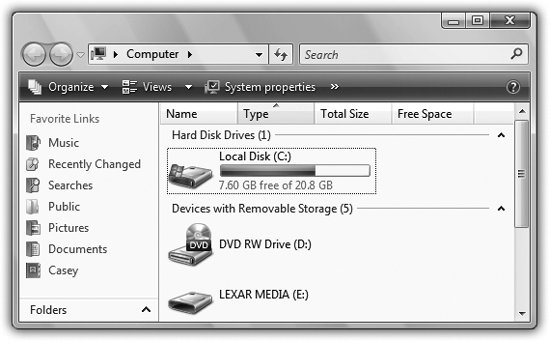Section 4.4. The Folders of Windows Vista
4.4. The Folders of Windows VistaThe top-level, all-encompassing, mother-ship window of your PC is the Computer window. From within this window, you have access to every disk, folder, and file on your computer. Its slogan might well be, "If it's not in here, it's not on your PC." To see it, choose Start No matter how you open the Computer window (Figure 4-5), you wind up face-to-face with the icons of every storage gizmo connected to your PC: hard drives, CD and DVD drives, USB flash drives , digital cameras , and so on.
Most people, most of the time, are most concerned with the Local Disk (C:), which represents the internal hard drive preinstalled in your computer. (You're welcome to rename this icon, by the way, just as you would any icon.) Tip: The drive letters , such as C: for your main hard drive, are an ancient convention that doesn't offer much relevance these days. (Back at the dawn of computing, the A: and B: drives were floppy drives, which is why you rarely see them any more.) 4.4.1. What's in the Local Disk (C:) WindowIf you double-click the Local Disk (C:) icon in Computerthat is, your primary hard driveyou'll find these standard folders: 4.4.1.1. UsersWindows' accounts feature is ideal for situations where different family members , students, or workers use the same machine at different times (Chapter 15.) That's the importance of the Users folder. Inside are foldersthe Personal folders , described in a momentnamed for the different people who use this PC. In general, standard account holders (Section 15.2.1) aren't allowed to open anybody else's folder. 4.4.1.2. Program FilesThis folder contains all of your applicationsWord, Excel, Internet Explorer, your games , and so on. 4.4.1.3. WindowsHere's a folder that Microsoft hopes you'll simply ignore. This most hallowed folder contains Windows itself, the thousands of little files that make Windows, well, Windows. Most of these folders and files have cryptic names that appeal to cryptic people. In general, the healthiest PC is one whose Windows folder has been left alone. (One exception: the Fonts folder contains the icons that represent the various typefaces installed on your machine. You're free to add or remove icons from this folder.) 4.4.2. Your Personal Folder Everything that makes your Vista experience your own sits inside the Users |
EAN: 2147483647
Pages: 175
 Computer, or double-click its icon on the desktop, if youve put it there (Section 5.5).
Computer, or double-click its icon on the desktop, if youve put it there (Section 5.5). 